Customer Experience Management vs. User Experence (Part III)
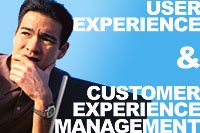 Continuing the posts on defining Customer Experience Management (CEM)… A number of consultancies and agencies equate CEM with User Experience. In our previous article, we outlined the five key disciplines, or components, of CEM.
Continuing the posts on defining Customer Experience Management (CEM)… A number of consultancies and agencies equate CEM with User Experience. In our previous article, we outlined the five key disciplines, or components, of CEM. User Experience, or “Usability” is focused on the interface discipline of CEM. The term is used primarily in reference to the analysis, design and/or development of human-to-technology interfaces. Some examples of this include creating, refining and managing:
User Experience is an important part of CEM, but like Experiential Marketing, it’s a part of a much larger whole. User Experience architects center their focus creating functional, intuitive interfaces (online or systems applications and technological devices) that enable customer interaction and transaction. CEM practitioners focus on the comprehensive interaction of customers in both online and offline channels.
Contrary to popular belief, User Experience is both an art and a science that requires a complex array of skills. Individuals who “do” usability can’t possibly embody all skills, although if you find a rare individual that does, you should pay them a mint! Dave Rogers of gotomedia recently wrote an excellent article about this in the gotoreport. Many of us will resonate with Dave’s frustration. To underscore Dave's assertions, here’s just a sampling of the functional roles that might found on a more complex user experience project:
While it might be natural for any individual to assume 2-5 of the roles described above, many of you feel the pain of being asked to manage many – or all – of the roles outlined above yourself, or within a limited internal team. My advice to you: Keep educating your company about the nature of user experience with articles like this one. Be sure to tangibly demonstrate the results and forge ahead! Fortunately (job security) and unfortunately (you may have no-life!), this isn't likely to get much easier. The demand for user experience professionals is likely to increase. Here's why:
1. Electronic channels are being integrated into traditional channels with increased frequency – and usability professionals are instrumental in helping us become more proficient and creative about how we use them. From increased integration of coupons, kiosks, wireless promotion… we’ll see more folks with traditional usability expertise being drawn into the broader CEM discussions. For example, the kiosk design team may be included in discussions on how to optimize kiosk use with in-store placement and visual positioning.As consumers continue to adopt new technology, and utilize technologically driven channels for interaction and transaction, user experience (human-to-technology) competency will continue to be a critical factor in driving effective customer experience. This is especially true as technology continues to evolve and devices begin to mature and converge, generating entirely new products and services for consumers.
2. Companies are beginning to apply more concentration on creating a more “seamless” customer experience across channels. Collectively this will force an increased demand for individuals with expertise in mapping out comprehensive experiences and designing interactions. This is a much-needed skill that must be applied within, and across traditional channels in order to effectively track and streamline the larger customer experience.
3. User experience resources are accustomed to a customer centric design bias (vs. business centric bias). They are therefore more familiar with behavioral customer dynamics – in addition to channel dynamics, and greatly suited to helping design interactions from a customer-centric perspective.
4. A growing awareness within companies for the need for user experience staff will drive increased hiring capability. This has already become visible in the job market today, as increasing number of user experience job descriptions present themselves. The ongoing challenge will be getting the position descriptions correct. As Dave points out in his article, most companies expect way too much from single resources.
Usability, as a part of CEM, will work to ensure technologically driven customer interfaces meet customer need, while additional attention will be focused by CEM practitioners on streamlining, synchronizing and improving holistic customer experiences across online and offline channels.
Customer Experience Management
vs.Experiential Marketing (Part II)
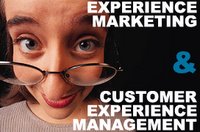 Continuing the dialog on defining Customer Experience Management (CEM)...
Continuing the dialog on defining Customer Experience Management (CEM)...Many individuals equate CEM with Experiential Marketing. However, the term "experiential marketing" has become perceptually aligned with marketing execution in recent years. This is because it largely focuses on developing highly visible, stimulating, interactive and sensory-engaging environments in which products and services are showcased. As such, experiential marketing is an important component of CEM, but it isn’t the “whole enchilada” (Ole').
The environments experiential marketers focus on are diverse. You'll often find a large emphasis on shaping the "walk-in" experience of brick and mortar environments. This is done with the goal of creating more positive, intuitive, memorable, engaging and pleasing environments which better engage, entertain and support customers. Some examples of this include:
Museums and galleries. Because they focus on creating a sensory experience, museums and galleries like the Guggenheim, the Smithsonian, and the San Francisco MOMA have always had a high level of focus on how to create the proper experiential environment for visitors and have therefore been proactive in the application of new technology to enhance experience and both preserve works of art for future visitors.Experiential Marketing carries with it as strong association with event-driven marketing. In the past, this has been primarily associated with trade shows, technology showcases and industry conferences. Howver, today, event-driven marketing tactics are becoming increasingly popular in non-traditional venues, such as:
Stores. Retail outlets that sell goods are placing increasing emphasis on developing more experiential environments. Visit REI and spend some time on the climbing walls available for public use. Walk in to a Build-A-Bear Workshop and create a custom toy, complete with a voice chip, for a friend or loved one. Other, more obvious experiential retail environments include Apple Stores, Niketown, the American Girl stores. More subtle examples include Sephora, Anthropologie, Origins and Libby Loo.
Restaurants. It's not just about food anymore. Restaurants are getting into the game, as well. Almost all of us are familiar with the time-tested experience offered by Chuck E Cheese. Some more modern examples of the Rainforest Cafe and Planet Hollywood. You don't have to be big to be experiential. My five year old niece's favorite restaurant is Sushi Takahashi, because of the circular sushi bar and the circling model train which delivers your order. My brother and I like it because the sushi is great, and cheap.
Non-traditional Environments, and is alive and well in several popular grocery chains, such as Wegman’s and Whole Foods. We’re also seeing forays into experiential marketing within the financial services (e.g. ING Cafés), health care (e.g. Minute Clinic) and other industries.
Microsoft's somewhat recent and highly successful multi-venue Tablet PC promotional event. Born out of a partnership between Microsoft and the Jack Morton agency the event resulted in 125,000 product demonstrations in high-traffic airport terminals in major hub airports across the country.As marketing becomes increasingly experiential in nature, the lines of demarcation between event-driven marketing and other promotions are becoming increasingly cloudy. For example:
Another example was featured recently in a recent CMO Magazine article on B2B experiential marketing. The article highlights IBM’s Merlin Center, an experiential environment created to effectively demonstrate the future of high technology banking to bank executives. The experience starts in a living-room like environment featuring warm biscotti and coffee. It gradually transitions into an experience that has been described as a "virtual themepark for banking executives."
Adrants recently gave a hat-tip to Lexus, which drew attention for strategically placed experiential displays positioned in Times Square and a several other key US locations. The displays, placed at sidewalk level in shop windows, featured a “holographic” animation of the IS in motion - zooming, spinning, turning and driving within the store window space. Interactive kiosks allowed visitors to control the display features, such as the color of the car. The displays drew substantial attention and shut down street corners successfully as onlookers jammed busy sidewalks.Experiential marketing also applies heavily to the online world, where the constant drive to innovate and improve customer experience and dynamic qualities are ever present. Product searching, personal recommendations, reviews, rating tools, list sorting/filtering and wish lists become common features of top retail and/or promotional sites.
Experiential marketing promotions were also featured in recent episodes of the hit TV show “The Apprentice.” In several shows, the teams were assigned the task of creating innovative marketing campaigns for Dick’s Sporting Goods and Tide, as well as innovative product displays for Best Buy’s video release of Star Wars III.
Today, companies strive to press the envelope of traditional interactivity further, to improve site and application usability. In addition to utilizing rich media, flash, DHTML, Java and Ajax to bring new, more engaging and effective sites to bear, an increasing number of companies are making good use of other techniques. Viral microsites, gaming, downloads and eCards are being used to help encourage site interaction and visitation. Blogs and podcasting are adding a whole new dimension to site interactivity and content. Product customization, enhanced products and services are an emerging trend.
Nike allows customers to create and customize their own athletic gear at NikeID.com.It occurs to me that I'm preachin' to the choir now. Many of you are highly familiar of the tenants of experiential marketing - and I haven't even addressed how the really great experiential marketers pay so much detail to interaction, they work to refine person-to-person interaction within these environments (e.g. the W Hotel), or engineer product displays to boost the efficacy of merchandising - among other things. However, in the interest of length, let's move on to discuss how experiential marketing relates to CEM.
Online stores like Lands End and The Gap’s "Watch Me Change" viral site allow customers to create customized avatars, based on the peronal height, weight and body style attributes. The avatars can “try on” selected clothing for the customer and allow style and fit comparisons. In the case of The Gap, you can also get them to perform an entertaining strip tease for you, and pass it along to a friend.
In addition to hosting an online car configurator, Mini Cooper has an interactive site somewhere (sorry, couldn't FIND the flash application while writing this article!) showcasing a wide number of customized roof wraps customers can puchase for their cars. The artwork includes the british flag, sci-fi scenes, the Mona Lisa and much more.
The Converse Gallery offers independent film makers the ability to submit 20 second short films, dedicated to the Converse brand. Many of the high quality "shorts" are now serving as part of Converse's national advertising campaign.
Unfortunately, many executives are being seduced by the flashier side of experiential marketing and can mistake it for CEM in its pure form. A cadre of agencies now purport to have expertise in experiential marketing and readily capitalize on opportunities presented by market shifts, retail expansion and new technologies. Typically, however, such agencies execute work within a relatively narrow scope - compared to full-blown CEM project work.
Confusion between experiential marketing and CEM often forces attention away from the real value and tangible benefits of CEM initiatives. The differentiation the two can be succinctly described as follows:
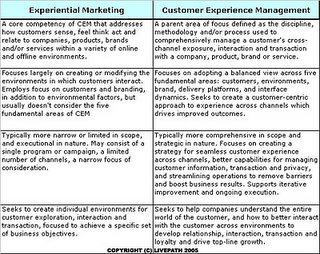
In closing, I'm not a huge fan of buzz words or hype. It's a simple truth that everything we do as marketers is experiential at some level - from the brand assets we create, to the packaging, collateral, IVR scripts we write, or the stores and web sites we manage. We have complete control over how "experiential", engaging or stimulating we are, and how perfunctory the interactions we design become. At times, perfunctory is better... and at other times, engaging, stimulating and sensory-involving is better.
Whatever the case, the companies that are faithful in the "little things" will be granted much more. Each little customer interaction is a highly valuable part of a larger set of interactions. The outcomes of customer interactions shape brand perception. Customer interactions should therefore be strategically designed and executed to work together to collectively lead the customer in an appropriate (and positive) direction that compliments personal goals and business objectives. This is the core focus of CEM.
The true leaders in customer experience understand these principles. They are adamant about creating experiences within channels - and across channels - that are intuitive, consistent, engaging, cohesive, safe, relevant, seamless, memorable and satisfying for customers. Experience leaders never get caught up in flash over substance, but leverage experiential marketing as an effective tool to gain exposure, attention and customer mindshare. They focus a great deal of energy on becoming increasingly proficient in the principles of Customer Experience Management.
Defining Customer Experience Management (Part I)
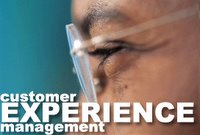 A growing number of books and articles are actively promoting the concept of Customer Experience Management (CEM). Popular leaders include Bernd Schmitt, author of “Customer Experience Management” and "Experiential Marketing". Joseph Pine and James Gilmore, co-authors of the book, “The Experience Economy” have also gained a great deal of exposure. You may have read “Managing the Customer Experience” by Shaun Smith, or “Customers.com” by Patricia Seybold. You may also have seen articles about and Harvard Professor, Gerald Zaltman, author of the book How Customers Think. There are also a growing number of agencies and consultancies claiming expertise in CEM – all with varying degrees of involvement and expertise in the arena.
A growing number of books and articles are actively promoting the concept of Customer Experience Management (CEM). Popular leaders include Bernd Schmitt, author of “Customer Experience Management” and "Experiential Marketing". Joseph Pine and James Gilmore, co-authors of the book, “The Experience Economy” have also gained a great deal of exposure. You may have read “Managing the Customer Experience” by Shaun Smith, or “Customers.com” by Patricia Seybold. You may also have seen articles about and Harvard Professor, Gerald Zaltman, author of the book How Customers Think. There are also a growing number of agencies and consultancies claiming expertise in CEM – all with varying degrees of involvement and expertise in the arena.While there’s a clear reason to become a staunch supporter of CEM, there’s a great deal of confusion over what it really is. As more individuals get on board the CEM band wagon and build services in the arena, confusion seems to be increasing. It’s time to demystify the hype:
Defining CEM
While no individual really “owns” the term “Customer Experience Management,” it is often attributed to Bernd Schmitt who, in 2003, defined CEM as “the process of strategically managing a customer's entire experience with a product or company." Building further on Schmitt’s definition:
The term "Customer Experience Management" represents the discipline, methodology and/or process used to comprehensively manage a customer's cross-channel exposure, interaction and transaction with a company, product, brand or service.
Five Functional Areas of CEM
When we look at the nature of Customer Experience Management, there are essentially five key areas that CEM practitioners or “Experience Architects” examine. While these are broken down consultants in slightly different manners, based on individual methodologies, they can be described, at a high level, as follows:
1. The Customer. CEM analysis focuses on developing a multidimensional understanding of customers. This understanding includes cultural, sociological, behavioral and demographic analysis, and culimates in a detailed ability to articulate the needs, wants, desires, expectations, conditions, context and intentions of various customer groups. This understanding informs audience segmentation and guides the prioritization of key segments. Customer analysis is proactively benchmarked against a company’s capability to meet customer needs - both in a present and future state capacity. Customer understanding therefore serves as the primary driver in shaping the business approach, aligning strategy and investment.
2. The Environment. Examining the “landscape for brand discovery” is an essential tenant of CEM. This landscape is comprised largely of market conditions, competitive factors, channel use (and channel/cross-channel dynamics), the process for purchasing (steps to buying), the “real” purchasing environment (store, phone, web, etc.) and the service environment. Leveraging this knowledge against customer analysis, CEM strategists work with companies to create integrated plans, which “order the paths” customers commonly follow in the purchasing process. These multi-path strategies work to ensure customers have an intuitive, pleasing experience at every step in the journey to brand discovery. As a part of Environmental Analysis, strategists also focus on applying experience innovation to customer environments, which remove barriers that confuse, inhibit, discourage or de-motivate customers, and create a more engaging, efficient, pleasing, personable or memorable environment within which to interact.
3. The Brand. From a tactical perspective, this analysis involves the development of visual identity, assets, tag-lines, communications, logos and other brand assets that help shape perception and define the brand in the marketplace. From a strategic perspective, however, this analysis focuses on innovation and differentiation. This includes the consistent and iterative evaluation, planning and refinement of product or service features, functionality, pricing, options, attributes, benefits and positioning of the company, service or product.
4. The Platform. A company’s operational infrastructure is the platform on which customer experience is delivered. As a result, operational efficiency has a direct impact on customer experience. As companies move from an “inside out” focus (on internal operational constraints such as production, capacity, etc.) to an “outside in” focus (on customer-centric delivery), operational analysis is essential. This includes comprehensive evaluation and improvement of people, process, policies, technology and systems that facilitate, track and measure customer interaction and transaction. CEM Platform analysis may include technology implementation, workforce evaluation, fulfillment and logistics analysis, process improvement, systems analysis, policy reviews and a myriad of other tasks. The goals of platform analysis include streamlining operations, increasing time to market, removing barriers to customer satisfaction, lowering costs and improving the overall customer experience by creating operational excellence.
5. The Interface. This area of CEM analysis focuses on the interaction between consumers and the brand, from a human-to-technology; human-to-human; and human-to-environment perspective. Simply defined, this area focuses on refining and optimizing the customer interaction within any channel to produce desired and pleasing outcomes. At a tangible level, CEM Interface analysis may center on improving the usability of electronic applications or products (e.g. a web site, a TIVO interface; or the buttons and information flow on a cell phone). However, it also concentrates on optimizing the interfaces within other channels, such as brick-and-mortar outlets. CEM strategists focus on how customers interact within, and across channels, often examining the end-to-end shopping and service delivery process. This may include task-based analysis of various interactions and transactions, such as a customer's discovery, browse, shop, purchase and post-sale experience. CEM practitioners focus on improving the quality and efficacy of customer dialog. This may include conducting analysis of the call-center or voice-response systems, as well as optimizng the approaches of sales or other customer-facing staff.
It’s relatively easy to find individuals who can work within one or two of the areas above. What separates CEM practitioners from the pack an adamant dedication to examine all five functional areas with companies to develop truly cohesive strategies and plans that result in tangibly improved customer experiences and better business outcomes.
It's easy to confuse CEM with CRM, Usability and "Experiential Marketing" ... we'll talk more in future posts about how it all fits together.
Resources for this article include materials produced by Bernd Schmitt; Joseph Pine/James Gilmore and other authors referenced in the initial paragraphs of this book.
eHarmony Strikes a Bad Chord!
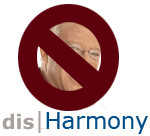 This is a bit of an intermissionary gripe session with a lesson attached for all those managing customer dialog and privacy.
This is a bit of an intermissionary gripe session with a lesson attached for all those managing customer dialog and privacy.I think I have grown to personally dislike Dr. Neil Clark Warren. He's the founder and public face of eHarmony.com. Because of this, can’t help but personally hold him responsible for six months of harassment from his company.
Out of curiosity, I signed up for a free eHarmony trial on May 15, 2005. I ended up canceling it after just a few days -- It just wasn't my thing. Unfortunately, eHarmony not only screwed up my account, I've had SIX MONTHS of interaction trying to get off their mailing list, yet they continue to spam me with unsolicited email!
Many of you read my previous post about spam problems with Ancestry.com and eHarmony. I promised to keep you informed, and the comments attached to the post reveal the outcome of the Ancestry.com issue.
Sadly, with eHarmony, things have gotten worse. After months, it seems pretty clear that the operational infrastructure in place for managing both privacy and customer inquiries at eHarmony is insufficient and unharmonious!
From a customer experience perspective, this is a great case study on how not to manage customer relationships. Here's a rundown of my ridiculous eHarmony experience:
5/12 I signed up for a free trial (this yielded more than six emails in five days! Very annoying!)
5/19 I requested cancellation via email
5/19 Got an automated response confirming receipt of my cancellation request
5/19 Got a personal response to cancellation request - telling me to call in to cancel.
5/19 I phoned in and got voicemail - The office was closed for a meeting
5/20 I phoned again. Got voicemail - The system was down for maintenance, and it was a Friday - and they were closed on the weekend. My seven day trial was ending and I didn't want to be charged.
5/20 I emailed my demand for cancellation again and warned them not to charge me. I also reiterated that I didn't want any future email from them. I had previously gone into my profile and cancelled all opt-ins.
Note: They didn't cancel my account and charged me $49.95 anyway.
5/26 Got a personal email from Cecelia at eHarmony confirming the cancellation of my account and subscriptions, and confirming issuance of a $49.95 refund.
Note: I thought the saga had ended... but...
6/9 Got a renewal reminder notice from eHarmony, reminding me that my account was expiring
6/9 I sent an inquiry asking why they asked me to renew my cancelled membership. I also reminded them that I had opted out on several occasions and should not be getting any email from eHarmony.
6/9 Got an automated response confirming receipt of my email
6/13 Got a personal email response from Louise saying eHarmony had cancelled account and all subscriptions
6/25 Got an eHarmony monthly Newsletter
6/25 I sent another email complaning about spam and warning them of Can Spam violation. Got no response to this email although there was no bounce when I sent it.
6/27 Got an email requesting my feedback about eHarmony (!?)
6/27 I sent some very harshly worded feedback complaining about their violation of the Can Spam act.
6/29 Got an automated Response from eHarmony confirming receipt of my email
6/30 Got an email from Armando at eharmony assuring me eHarmony has taken me off all mailing lists.
Early July - another email newsletter came. I angrily deleted it.
7/21 Another email Promotion Arrived: Win a Cruise for eHarmony's Couple of the Year - saved this one by mistake.
Mid August - Another Newsletter arrived. I angrily deleted this, too.
9/19 Another eharmony Newsletter.
9/25 Another Offer: Start Communicating Today: 3 for the price of 1!
10/20 Another eHarmony Newsletter
11/16 I sent eHarmony a letter warning them of legal action, with a complete rundown of my contact history. The title was "Warning of Legal Action"
11/16 Got an automated Response from eHarmony confirming receipt of my email.
11/17 Got a personal letter from eHarmony (Viviana) telling me that unfortunately, they could not extract my photos for attachment to my profile. (????)
11/17 I sent an even angrier letter back, copying everyone possible. Also filed a complaint with the FTC and TrustE.
It's clear that eHarmony has invested a lot into the wording of their stock responses. Lord knows I've read enough of them! Unfortunately, it's also clear that their processes for managing customer inquiries are insufficient. It's also very clear that they have a flawed infrastructure for managing consumer opt-out, which makes me question the solidity of their privacy promise, as well.
According to Federal Can Spam legislation, eHarmony is obligated to take me off all mail lists within 10 days of my request. This means that after 5/29/2005, they should have stopped bugging me. This was approximately six months ago, minus two weeks. eHarmony - consider this article my anniversary gift.
The lesson is this: Fluffy words and promises can't make up for ridiculously flawed experience. You must deliver! It's impossible to deliver if your infrastructure is a mess! Drop the ball once and you may be forgiven. Drop the ball twice and you'll probably lose your customer. Drop the ball repeatedly and you may lose more than one customer as your pattern is established. You may also violate state or federal law and run the risk of being sued.
If any of you have had problems with eHarmony please share your stories with me! I will keep you posted on the continuing saga. :-P I have conducted a bit of research on eHarmony and have discovered a NUMBER of sites that catalog customer experience concerns and complaints - many of which will surprise you! Check out these links to read for yourself!
Back in the Saddle
 So, I'm back in town and working on some writing and other work. It's hard to come up with anyting profound right now. I think may have left my brain on a beach in Hawaii! This was my second trip there, and it was outstanding. After teaching, I spent my time on the S's - Surf, Sand, Scuba, Snorkel, Sleeping and Sushi. Got lucky with low surf for a spectacular day of diving. There's nothing quite like swimming through coral canyons and caves... or laying on the sandy ocean floor blowing bubble rings and watching them rise to the surface. I've posted some of my photographs on Flikr... More later. - L
So, I'm back in town and working on some writing and other work. It's hard to come up with anyting profound right now. I think may have left my brain on a beach in Hawaii! This was my second trip there, and it was outstanding. After teaching, I spent my time on the S's - Surf, Sand, Scuba, Snorkel, Sleeping and Sushi. Got lucky with low surf for a spectacular day of diving. There's nothing quite like swimming through coral canyons and caves... or laying on the sandy ocean floor blowing bubble rings and watching them rise to the surface. I've posted some of my photographs on Flikr... More later. - L
Bathroom Usability
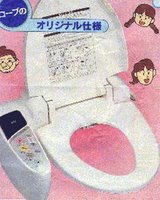 As many of you know, I am currently doing some teaching and doing a little rest and relaxation in Hawaii. Yesterday, I watched a Japanese woman helplessly fuss with the paper towel dispenser in a public restroom at Hanauma Bay: She was trying to pull the shreds of paper towels out of the greedy jaws of the dispenser, not realizing there was an "inviso handle" that would unjam the towel jam. After helping her out, I got to thinking:
As many of you know, I am currently doing some teaching and doing a little rest and relaxation in Hawaii. Yesterday, I watched a Japanese woman helplessly fuss with the paper towel dispenser in a public restroom at Hanauma Bay: She was trying to pull the shreds of paper towels out of the greedy jaws of the dispenser, not realizing there was an "inviso handle" that would unjam the towel jam. After helping her out, I got to thinking:Forget web sites and technology interfaces for a minute. What about public bathrooms? They generally rank high on the "suck meter" for usability and customer experience. Here are just a few common irritants:
- Horrid stall doors with locks that never seem to work
- Hand dryers that wouldn't blow an eyelash of your skin
- Toilet and sink sensors that play hit or miss games
- Soap dispensers that regularly fail, or are empty
- Small, narrow, wall-mounted garbage bins overflowing with trash
- Double roll vice-grip dispensers that will not dispense the T.P.
- Banked sink counters, which collect puddles of water that A) dampen your personal property if you set it down; and B) Dampen your garments if you lean in to wash your hands
- Airport bathroom stalls too narrow for a person and a roll-aboard
Who was the braniac that invented the gigantic roll of one-ply toilet paper?!
"Giganto-roll" is inevitably too heavy (unless half empty) to rotate with a single ply pull. in, find free end of the paper, and pull it to get a few squares --- or some shreds. Pull it again - get more shreds, which will begin to litter the floor.
To get enough paper out of a Giganto dispenser - installed above shoulder level while sitting, you must twist at the waist and, in awkward feat of acrobatics, reach over to pull the paper with one hand while "coaxing" the wheel of paper around with your other hand. I call this move the "Twist and Shuffle."
If you are lucky enough encounter a Giganto Roll installed, as they often are, below the handicap railing - at armrest level - you get to try an even more sophisticated move. While twisting, you must also bend at the waist to reach up UNDERNEATH the dispenser to blindly locate end of the toilet paper, and then shimmy the giganto roll around in circles. I call this move "The Angry Squirrel"
Now, while you are in the impossible act of squirreling away to get your measly squares of TP from the dispenser you will often get another thrill. This one is one of my favorites (NOT). As you bend over, the automatic toilet flush sensor will inevitably pick up your movement and WHOOSH -- flush the toilet while you're in mid-squat! Let's call this the "Involuntary Water Ride." Awful!
After you recover from your in-stall experience, compose yourself, leave the stall to endure the entire handwashing experience, you must then check yourself for "Clingons" - the micro shreds from the failed Giganto pulls .... clinging to your pant cuffs and/or shoe heels. Charming!
Okay, so probably enough time dedicated to this subject. Maybe I'm just too jet-lagged to be more profound, but I thought his was worth mentioning. Don't even get me started on the "Perch and Hover" (We've ALL done that!).
As for a solution? I dunno. I'm not sure there's really enough incentive for anyone to improve bathroom usability. I mean, it's not like they'll give out an award for public bathroom innovation. But who knows -- it's the era of social media where people have more power! It sure would be nice to see some improvement.
So all you architects and contractors out there: some food for thought! ;-)
The image is a picture of complicated, multi-function toilet which frightened my pal, Kelly Goto in Japan. This is probably proof that things won't be getting easier for us any time soon.
Free: Not Always a Good Price
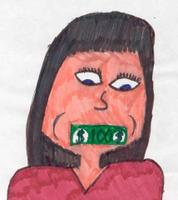 I'm a true fan of free web content when it's high quality. I find value coming out of sites like Marketing Profs.com and Marketing Sherpa all the time - as well as several blogs listed on my resource page. However, there are days when I get what I pay for.
I'm a true fan of free web content when it's high quality. I find value coming out of sites like Marketing Profs.com and Marketing Sherpa all the time - as well as several blogs listed on my resource page. However, there are days when I get what I pay for. For example, I recently listened to an archived, free Webinar called "Speak and Get Results: Maximizing Your Impact During Webcasts" offered by a popular site on the web. The speaker, 25-year executive coaching veteran with a PhD in Psychology, seemed to promise alot. So, I came in with high expectations. However, his delivery was very disappointing:
--> Stopped midstream to ask moderator how to advance slides
--> Had to silence his own ringing cell phone midstream
--> Boring text/graphics in "mud" tones
--> Featured FIVE slides of pictures of himself(!?)
--> Drifted off verbally - seemed to be multitasking on something?
--> Tonality seemed a little patronizing - lots of simple repetition
--> Encouraged us to "watch the audience response" - during a webcast?
--> Not specific to web-based speaking/presentation
--> No summary of prescribed action or steps to take
--> No provision of helpful resources or checklists
--> Easy to get a tickle when you're talking... but please excuse yourself when you hack repeatedly !
Ultimately, the elements above damaged his delivery as well as my experience. I couldn't help but think, "Maybe he had a bad day, poor guy!" So, in interest of fairness, I reloaded the audio and listened to the entire presentation - beginning to end. While he had some decent points about enunciation, tone, and breathing, I still wouldn't recommend the webinar and had great trouble sitting through it.
Afterward, I did a little thinking and decided to put together my own list of best practices for effective web-based presentation... Now, I'm no PhD... just a chick that's thinking out loud. This is definitely free advice, so be warned that may only be worth what you pay for it. ;-)
Wonderful image is courtesty of a young artist from public school district 68 in Nainamo, British Columbia.
Tips for Effective Web Presentation
As follow-up to my post, in which I slammed a recent webinar presenter's efficacy of presentation ... Here's my own checklist of best practices for delivering a good web-based presentation:
Planning Your Pitch
Develop a clear picture of audience needs, desires, problems
Structure "the story" & plan out flow: Intro, Body, Close
Keep it simple: limit to a number of key points (e.g. 3-5)
Use only helpful visuals to reinforce concepts
Strive to meet your audience needs - not self-promote
Clearly develop the "next step" recommendation
Meet with meeting partner to discuss flow, ideas & needs
(if applicable)
Before Your Web Presentation
Master material: Don't read a script -have a conversation!
Practice: tape yourself/ watch & listen or get feedback from others
Do a tech dry run; know how to use meeting tool(s)
Do a content dry run to verify timing & pace
Provide your bio to the moderator and discuss introduction
Silence cell phones, pagers and computer IM/Audio
Include barking dogs, mewing cats, screaming children as necessary!
During Your Web Presentation
Welcome your audience with enthusiasm
Introduce yourself and briefly outline key presentation objectives
Use a brief web survey to get to know audience
Share survey results with audience to build community
Tailor your pitch (e.g. examples) midstream toward audience
Provide real life examples that demonstrate cause & effect
Periodically reference slide visuals/numbers to help audience follow
Speak at a clear, even, and reasonably slow pace: R-tik-U-Late.
Exhibit passion, conviction and inflection
Smile while you are talking - it actually comes across.
Do make sure you breathe - it loosens you up and unkinks things!
Use pauses to reinforce points or build transitions
Avoid "gap filling" with words or phrases like "ummm" or "anyway..."
Closing Your Web Presentation
Summarize key points and underscore recommended action
Thank the audience and moderator for their time
Provide a list of helpful resources
Open the floor for questions
If you don't have an answer to a question, offer to get one
Provide appropriate contact information
After Your Pitch
Consider sending incentive or thank you to your audience (e.g. link to slides, a free book or white paper) to reinforce the bond you develop with your audience
Make sure you're tapped in to post-presentation feedback survey feedback!
Obtain any previously agreed upon audience leads & conduct follow-up
Refine and tweak your presentation (content, style, points) to address feedback
In conclusion, using online meetings can be a highly engaging and effective way to use time and close distance gaps for remote teams. Today, there's a really low barrier to entry for anyone, and applications like WebEx and GotoMeeting (which both offer pay-per-use options) make it easy and cost-effective to run high quality online discussions.
Following these basic, common sense rules can help anyone develop and deliver a more successful web-based presentation. Feel free to post your own tips, comments, ideas, links or questions by adding comments below.
Planning Your Pitch
(if applicable)
Before Your Web Presentation
Include barking dogs, mewing cats, screaming children as necessary!
During Your Web Presentation
Closing Your Web Presentation
After Your Pitch
In conclusion, using online meetings can be a highly engaging and effective way to use time and close distance gaps for remote teams. Today, there's a really low barrier to entry for anyone, and applications like WebEx and GotoMeeting (which both offer pay-per-use options) make it easy and cost-effective to run high quality online discussions.
Following these basic, common sense rules can help anyone develop and deliver a more successful web-based presentation. Feel free to post your own tips, comments, ideas, links or questions by adding comments below.
Subscribe to:
Posts (Atom)
FAVORITES
- On Trust & Influence
- Don't be Social Media Sharkbait
- The Social Media Engagement Continuum
- 10 Tips for Twitter Unmarketing
- Five Experience Funamentals
- Experience & Branding: The Three Word Rule
- Get Some Experience Healing!
- Discovering Customer Experience Pitfalls
- Not My Job: The CX Enemy
- Shoe Carnival: Watch Out for Carnies!
- Bathroom Usability
RECENT COMMENTS
SEARCH
LEIGH DURST

I’m Leigh Durst, a 20 year veteran in business, operations, customer strategy, ecommerce, digital & social media and marketing. Simply put, I’m a strategist that helps companies (start-up to blue chip) achieve business shift, create more compelling online and offline experiences. I also write, speak and teach about experience design and next-generation business. I’m a futurist, visionary, strategist, doer and connector with a passion for people and helping others. When I’m not on the road, you’ll find me in the San Francisco bay area, working, beaching it and hanging out with my family and dog.
Labels
Best Practices
CX
Community
Content
Copy writing
Customer Experience Leaders
Customer Relationship Management
Defining Customer Experience Management
Ethics
Group Think
Harassment
Innovation
Plagiarism
Plurk
RESOURCES
Social Media
Social Media Expert
Twitter
UX
Web 2.0
Web Strategy
advertising
air travel
bank experience
bathrooms
branding
brick and mortar retail
charlene li
cottonelle
customer centricity
customer experience
customer experience files
customer experience management
customer experience pitfalls
customer experience; innovation;
customer research
economy
experience best practices
experience file
experience pitfalls
good customer experience
infrastructure
life
marketing
marketng
motherhood
old navy
personal
privacy
reinvention
restaurant experience
retail experience
security
social networking
starbucks
stuck
target
toilet paper
trust agents
trust continuum
usability best practices
user experience
user experience
word-of-mouth

